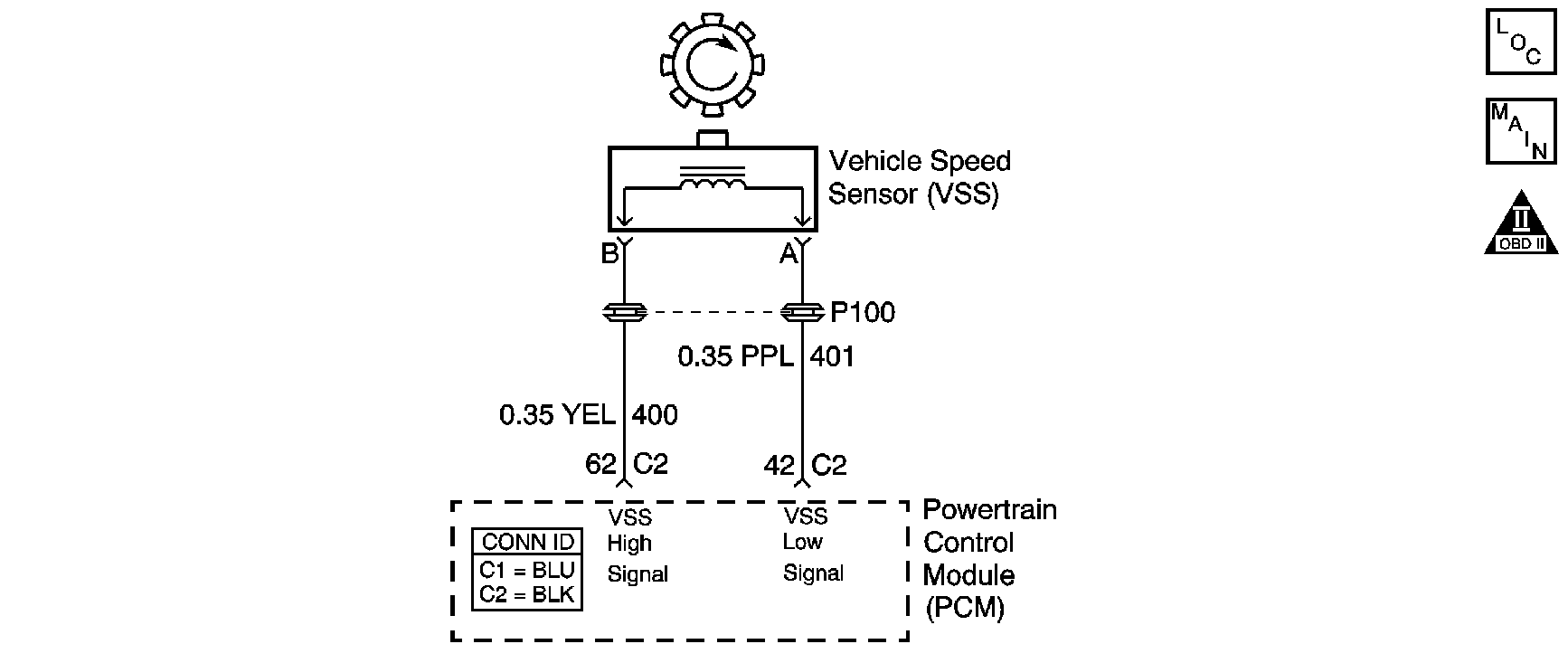
Circuit Description
Vehicle speed information is provided to the powertrain control module (PCM) by the vehicle speed sensor (VSS). The VSS is a permanent magnet generator that is mounted on the transaxle and produces a pulsing voltage whenever vehicle speed is over 5 km/h (3 mph). The AC voltage amplitude and frequency increases with vehicle speed. The PCM converts the pulsing voltage into km/h (mph). The PCM supplies the necessary signal to the instrument panel for speedometer, odometer operation and to the cruise control and multi-function alarm module.
Conditions for Running the DTC
| • | Engine speed is 1,700-3,600 RPM. |
| • | Throttle position is 0-1 percent. |
| • | Engine vacuum is 70-80 kPa (10-12 psi). |
| • | The above conditions are met for 5 seconds. |
Conditions for Setting the DTC
Vehicle speed is less than 3 km/h (2 mph).
Action Taken When the DTC Sets
| • | The PCM illuminates the malfunction indicator lamp (MIL) on the second consecutive drive trip that the diagnostic runs and fails. |
| • | The PCM disables Cruise Control. |
| • | The PCM commands the coolant fan ON. |
| • | The PCM records the operating conditions at the time when the Conditions for Setting the DTC are met. The PCM stores this information as Freeze Frame and Failure Records. |
| • | The PCM stores P0502 in PCM history. |
Conditions for Clearing the MIL/DTC
| • | The PCM turns OFF the MIL during the third consecutive trip in which the diagnostic runs and passes. |
| • | The PCM cancels the DTC default actions when the fault no longer exists and the DTC passes. |
| • | The PCM clears the DTC from PCM history if the vehicle completes 40 warm-up cycles without an emission related diagnostic fault occurring. |
| • | A scan tool can clear the MIL/DTC. |
Diagnostic Aids
Ensure the VSS is correctly torqued to the transmission housing.
Test Description
The numbers below refer to the step numbers on the diagnostic table.
-
This step ensures that the technician performed a Diagnostic System Check - Manual Transmission.
-
This step tests to see if the PCM is receiving a signal from the VSS using the scan tool.
-
This step tests the entire VSS system for proper output voltage.
-
This step tests the VSS High Signal and VSS Low Signal circuits for opens, shorts and high resistance.
-
This step ensures the technician inspects the VSS related mechanical components and mounting.
-
This step verifies if the PCM has taken required action after setting DTC P0502.
-
This step tests the VSS High Signal and VSS Low Signal circuits for total circuit resistance. The lower resistance value given represents the nominal resistance specification of the VSS at -40°C (-40°F), minus the manufacturing tolerance specification of 10 percent. The higher resistance value given represents the nominal resistance specification of the VSS at 150°C (302°F), plus the manufacturing tolerance specification of 10 percent.
-
This step replaces the PCM. The replacement PCM must be programmed and the crankshaft position system variation procedure must be performed. Refer to the latest Techline procedures for PCM reprogramming and to CKP System Variation Learn Procedure in Engine Controls.
-
This step validates that the repair has fixed the DTC under normal operating conditions.
Step | Action | Value(s) | Yes | No | ||||
|---|---|---|---|---|---|---|---|---|
Did you perform the Diagnostic System Check - Manual Transmission? | -- | Go to Step 2 | ||||||
Notice: In order to avoid damage to the drive axles, support the lower control arms in the normal horizontal position. Do not run the vehicle in gear with the wheels hanging down at full travel. Is the vehicle speed greater than the specified value? | 0 km/h (0 mph) | Go to Step 3 | Go to Step 4 | |||||
Is the speedometer operating normally? | -- | Go to Step 12 | Go to Step 4 | |||||
Is the AC voltage equal to or greater than the specified value? | 0.5 V AC | Go to Step 5 | Go to Step 6 | |||||
Is the total resistance within the specified value? | 977-2,354 ohms | Go to Step 11 | Go to Step 6 | |||||
Did you find any of the above conditions? | -- | Go to Step 8 | Go to Step 7 | |||||
Did you find any damage? | -- | Go to Step 9 | Go to Step 10 | |||||
8 | Repair the affected VSS High signal or VSS Low signal circuit, as necessary. Did you complete the repair? | -- | Go to Step 12 | -- | ||||
9 | Replace the VSS rotor or make any necessary repairs to the VSS mount. Did you complete the repairs? | -- | Go to Step 12 | -- | ||||
10 | Replace the VSS. Refer to Vehicle Speed Sensor Replacement . Did you complete the repairs? | -- | Go to Step 12 | -- | ||||
Replace the PCM. Refer to Powertrain Control Module Replacement in Engine Controls - 2.2L (L61). Did you complete the repairs? | -- | Go to Step 12 | -- | |||||
Does the scan tool indicate that this diagnostic has run and passed? | -- | System OK | Go to Step 2 |
